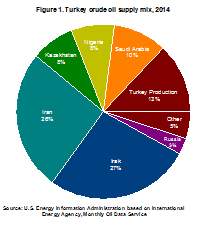
Feridun Demir
Associate Professor of Chemical Engineering at the Osmaniye Korkut Ata University in Osmaniye, Turkey
Title: Petroleum sector in Turkey
Biography
Biography: Feridun Demir
Abstract
Among OECD countries, Turkey has the highest rate of increase in energy demand since 2010, and it is noteworthy that it depends on energy imports to a large extent. The continuation of the decline in oil prices in 2015 has enabled Turkey to reduce its oil and natural gas import costs as well as other oil and natural gas importing countries. The crude oil supply of Turkey in 2014 is shown in Figure 1.
In 2015, Turkey produced approximately 51 thousand v/d crude oil per day. Whereas, 796 thousand v/d crude oil was consumed; import of crude oil at 503 thousand v/d level and 242 thousand v/d imports of finished goods were realized. Compared with the year 2014, while imports of finished products showed a decline, crude oil imports and crude oil consumption increased. In 2015, the total consumption rate of domestic crude oil production was 6.4%. The consumption rate of Turkey’s domestic natural gas production in 2015 was the lowest in the last decade and realized as 0.8%. In other words, Turkey's import dependency rate for petroleum is 93.6%, and natural gas import dependency rate is 99.2%. In 2015, the distribution of petroleum imported by Turkey according to the source countries has changed considerably compared to the year 2014. It is observed that in 2014, 90% of the imports are made in only six countries, while in 2015 the source country balances have changed. Iraq ranks first with 29%, Russia second with 18%, Iran third with 14%. Compared to 2014, the rate of oil imports from Iran and Saudi Arabia has fallen, while the share of Russia and India has risen considerably. When we look at the source countries where oil is imported in 2015, the most noteworthy point is the diversity of countries where oil is imported at low levels.


